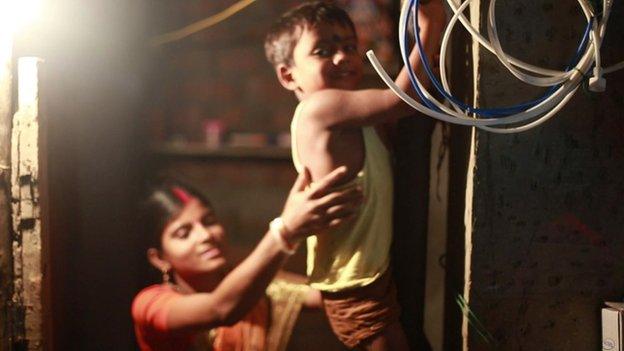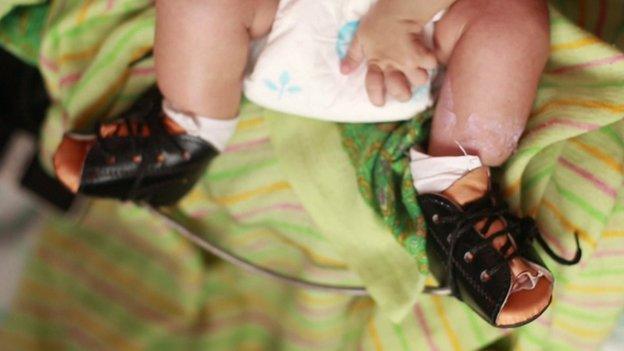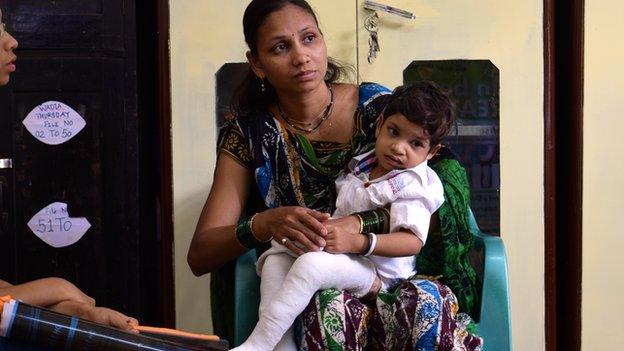Canvassing support: Helping children with clubfoot
- Published
Feet for Life: New ways of treating children with deformed feet in India
Clubfoot is one of the world's most common birth defects, affecting around one in 1,000 babies.
A child born with the condition needs the right treatment - gently realigning the foot - to ensure they grow up being able to walk properly.
It is treatable, for those babies born in developed countries. But up to 80% of those with clubfoot in developing countries go untreated.
Now a charity has developed a low-cost canvas brace for children to wear as part of their treatment - which is being tested for use in India, where around a quarter of the 200,000 children with clubfoot live.
'A normal life'
Pradeep Das, now four years old, was born with clubfoot and currently has to wear a brace for around 16 hours a night.
His father, Ranjeet, suffers from the same condition but was never treated.
"We realised Pradeep's feet pointed the wrong way when he was 10-months-old," said Ranjeet.
"What could I do? I was worried because I am already living with this."
"So I took him to Wadia hospital and the doctor there said he'll be corrected."

Pradeep plays in the construction site where he and his family live
Ranjeet works in construction and like many in Mumbai, his family moves around the unfinished buildings he works on. The buildings are often crowded, dusty, badly ventilated and have few basic amenities.
"It's a long time to wear the brace but what can I do?" said Pradeep's mother, Sunita.
"It hurts him and he cries but I can't do anything. If it makes him better then he has to tolerate it and so do I.
"If this allows him to live life like a normal person then we'll do it."
First weeks

The Steenbeek brace is cheap to make but can be problematic
Clubfoot affects around 200,000 babies every year.
It results from the abnormal development of muscles, tendons and bones in the foot during pregnancy which makes the foot twist downwards and inwards, making it difficult to walk.
The main way of treating the condition across the world is the Ponseti method.
Pioneered by Spanish physician Dr Ignacio Ponseti, it involves correcting the feet by gently stretching the tendons and ligaments in the foot so they assume the right position with a series of braces and plaster casts.
Treatment ideally starts in the first few weeks of life.
Once a child has received the initial treatment, they must wear a foot brace for between 16 and 23 hours a day for four to five years, to prevent the feet from turning back in.
Just like the braces used for teeth, the foot eventually assumes a new, straightened position.
And unlike surgery, which can in some cases lead to pain and problems in later life, the Ponseti method has been shown to correct the foot in such a way that patients lead completely normal lives.
'User-friendly'
India has the highest incidence of clubfoot worldwide, with between 40,000 and 50,000 children born with the condition each year, so the brace is being tested there.
It is there that the Miraclefeet charity is about to trial a low-cost easier-to-wear brace for children to wear as part of their treatment.
Designed by a group made up of Clarks Shoes, Stanford Design School and Suncast, a US plastics company it costs less than $20 (£12.80), around the same as the brace most commonly used at the moment, the Steenbeck, costs.
The Miraclefeet brace is made of canvas, rather than leather, so is lighter to wear in hot climates. It is also padded and clips on in two separate places and it is hoped parents will see it as more "user friendly".
As well as the trials in India, over the next few months the Miraclefeet will deliver braces to clinics in the Philippines, Liberia, Nicaragua, Mexico, South Africa, Ecuador and Brazil.

Plaster casts are a standard part of the Ponseti method
"Our goal is to make sure that no person is living with clubfoot," said Leslie Lloyd, Program Associate of the charity Miraclefeet.
"We want all children to get treatment as soon as they're born and we want to see neglected clubfoot completely eradicated from the world."
The lack of high quality, low cost braces has been a major hurdle to expanding clubfoot programs around the world, according to campaigners.
"Correcting something is one part of the job," said orthopaedic surgeon, Dr Rujuta Mehta at the Wadia Children's hospital in Mumbai, who is treating Pradeep.
"But maintaining and making sure there is no recurrence or relapse as the child grows is equally important."
'Better chance'
India currently uses the Steenbeek brace, comprising two leather shoes connected by a steel rod. Produced locally, it costs around $10 (£6.30) but it has significant limitations.
The leather shoes cause irritation and skin rashes in hot climates.
Additionally, the brace can easily be bent out of shape and it is difficult to wear.
"The conventional brace is all one piece, so it's very difficult to get a crying, howling, non-cooperative child to wear both the feet at the same time," said Dr Mehta.
Ranjeet struggled through life with his disability. But he hopes that with the help of Dr Mehta - and the Miraclefeet brace - his son Pradeep can have a better chance of succeeding in life.
"I have suffered a lot in my life," said Ranjeet. "Now that my son's condition is improving, I'm very happy."

The latest in brace design could be the low-cost answer to curing clubfoot